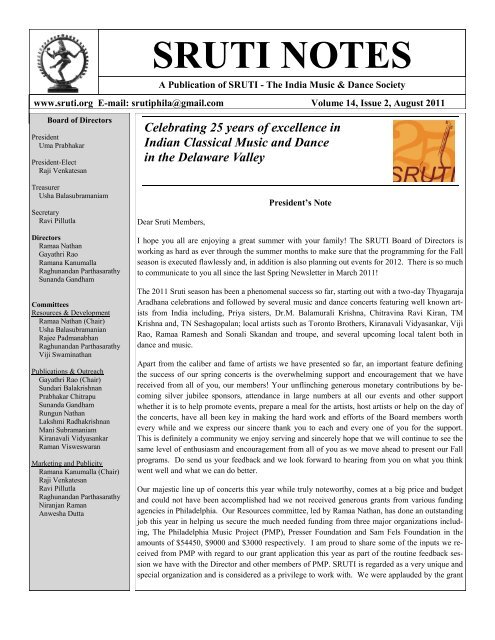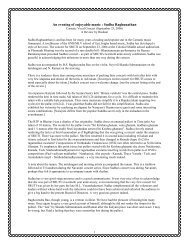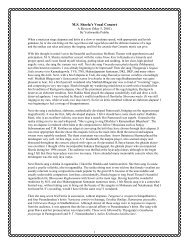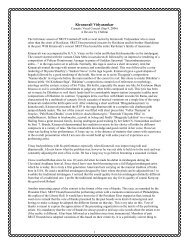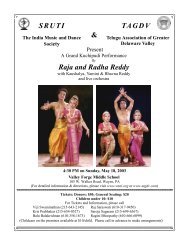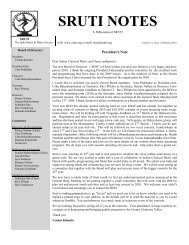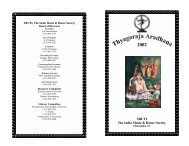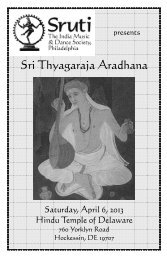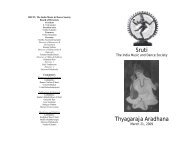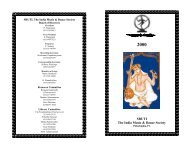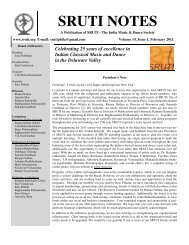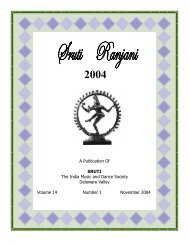SRUTI NOTES
SRUTI NOTES
SRUTI NOTES
Create successful ePaper yourself
Turn your PDF publications into a flip-book with our unique Google optimized e-Paper software.
<strong>SRUTI</strong> <strong>NOTES</strong><br />
A Publication of <strong>SRUTI</strong> - The India Music & Dance Society<br />
www.sruti.org E-mail: srutiphila@gmail.com Volume 14, Issue 2, August 2011<br />
Board of Directors<br />
President<br />
Uma Prabhakar<br />
President-Elect<br />
Raji Venkatesan<br />
Celebrating 25 years of excellence in<br />
Indian Classical Music and Dance<br />
in the Delaware Valley<br />
Treasurer<br />
Usha Balasubramaniam<br />
Secretary<br />
Ravi Pillutla<br />
Dear Sruti Members,<br />
President’s Note<br />
Directors<br />
Ramaa Nathan<br />
Gayathri Rao<br />
Ramana Kanumalla<br />
Raghunandan Parthasarathy<br />
Sunanda Gandham<br />
Committees<br />
Resources & Development<br />
Ramaa Nathan (Chair)<br />
Usha Balasubramanian<br />
Rajee Padmanabhan<br />
Raghunandan Parthasarathy<br />
Viji Swaminathan<br />
Publications & Outreach<br />
Gayathri Rao (Chair)<br />
Sundari Balakrishnan<br />
Prabhakar Chitrapu<br />
Sunanda Gandham<br />
Rungun Nathan<br />
Lakshmi Radhakrishnan<br />
Mani Subramaniam<br />
Kiranavali Vidyasankar<br />
Raman Visweswaran<br />
Marketing and Publicity<br />
Ramana Kanumalla (Chair)<br />
Raji Venkatesan<br />
Ravi Pillutla<br />
Raghunandan Parthasarathy<br />
Niranjan Raman<br />
Anwesha Dutta<br />
I hope you all are enjoying a great summer with your family! The <strong>SRUTI</strong> Board of Directors is<br />
working as hard as ever through the summer months to make sure that the programming for the Fall<br />
season is executed flawlessly and, in addition is also planning out events for 2012. There is so much<br />
to communicate to you all since the last Spring Newsletter in March 2011!<br />
The 2011 Sruti season has been a phenomenal success so far, starting out with a two-day Thyagaraja<br />
Aradhana celebrations and followed by several music and dance concerts featuring well known artists<br />
from India including, Priya sisters, Dr.M. Balamurali Krishna, Chitravina Ravi Kiran, TM<br />
Krishna and, TN Seshagopalan; local artists such as Toronto Brothers, Kiranavali Vidyasankar, Viji<br />
Rao, Ramaa Ramesh and Sonali Skandan and troupe, and several upcoming local talent both in<br />
dance and music.<br />
Apart from the caliber and fame of artists we have presented so far, an important feature defining<br />
the success of our spring concerts is the overwhelming support and encouragement that we have<br />
received from all of you, our members! Your unflinching generous monetary contributions by becoming<br />
silver jubilee sponsors, attendance in large numbers at all our events and other support<br />
whether it is to help promote events, prepare a meal for the artists, host artists or help on the day of<br />
the concerts, have all been key in making the hard work and efforts of the Board members worth<br />
every while and we express our sincere thank you to each and every one of you for the support.<br />
This is definitely a community we enjoy serving and sincerely hope that we will continue to see the<br />
same level of enthusiasm and encouragement from all of you as we move ahead to present our Fall<br />
programs. Do send us your feedback and we look forward to hearing from you on what you think<br />
went well and what we can do better.<br />
Our majestic line up of concerts this year while truly noteworthy, comes at a big price and budget<br />
and could not have been accomplished had we not received generous grants from various funding<br />
agencies in Philadelphia. Our Resources committee, led by Ramaa Nathan, has done an outstanding<br />
job this year in helping us secure the much needed funding from three major organizations including,<br />
The Philadelphia Music Project (PMP), Presser Foundation and Sam Fels Foundation in the<br />
amounts of $54450, $9000 and $3000 respectively. I am proud to share some of the inputs we received<br />
from PMP with regard to our grant application this year as part of the routine feedback session<br />
we have with the Director and other members of PMP. <strong>SRUTI</strong> is regarded as a very unique and<br />
special organization and is considered as a privilege to work with. We were applauded by the grant
(Continued from page 1)<br />
reviewers for our superb grantsmanship, curatorial expertise,<br />
high caliber artist selection, quality of workshops and lec/dem<br />
presentations and excellent choice of venues!<br />
The strong attendance that we have seen at every single concert<br />
this year is the result of the directed and enhanced marketing<br />
and promotional efforts that our Marketing and Publicity<br />
Committee, led by Ramana Kanumalla, has put together. Their<br />
untiring and enthusiastic efforts in promoting our events<br />
through attractive posters and flyers especially designed for<br />
the occasion, distributing flyers and evites, and making presentations<br />
at various venues downtown and at Indian events<br />
have paid off richly and enabled us to break even and even<br />
enjoy marginal net incomes at every single concert so far. We<br />
are confident that we will continue this trend in the second<br />
half of the year as well and we will be able to tuck away some<br />
revenues for the next year's programs and beyond!<br />
The highlights of the Publication and Outreach Committee,<br />
chaired by Gayathri Rao is conspicuous in the two extremely<br />
high quality publications that were released earlier this year<br />
namely, The Thyagaraja Aradhana Souvenir in March 2011<br />
and the May 2011 Memorial Day Souvenir, 'Great Composers<br />
of India'. Well designed program notes that you pick up at<br />
concerts is carefully prepared to enhance your concert experience<br />
at each and every event. The publications team is now<br />
working on a few other new fun initiatives this year in addition<br />
to maintaining an updated website to help you navigate<br />
and keep you abreast of our upcoming events. We know you<br />
will enjoy the new surprises that have been planned for the<br />
Fall of 2011!!<br />
As always, our <strong>SRUTI</strong> Youth Group led by Anil Chitrapu and<br />
Harsha Kanumalla and advised by Sunanda Gandham, continue<br />
to make outstanding contributions to Sruti. Their interview<br />
videos certainly have a more professional flair to them<br />
and have reached a whole new level. The high quality of the<br />
interviews and the videos attest to the caliber, hard work and<br />
dedication of our youngsters. The Youth group has also continued<br />
to help us in the execution of our concerts in various<br />
ways.<br />
We hope that the Youth group will continue to be an integral<br />
part of <strong>SRUTI</strong> in the years to come and look forward to engaging<br />
more youngsters in leadership roles within this group.<br />
Please check out our calendar for the line up of the Fall events<br />
at our website, www.sruti.org, which includes among several<br />
other concerts, workshops by the music practitioners of Indian<br />
classical music to explore the convergence of Carnatic and<br />
Hindustani music during the Labor Day weekend. We look<br />
forward to seeing you all at all our Fall events and hope you<br />
will continue to have an enjoyable and satisfying experience at<br />
these concerts.<br />
With warm regards,<br />
Uma Prabhakar<br />
on Behalf of the <strong>SRUTI</strong> Board of Directors<br />
——————————————<br />
From the Publications and Outreach Committee<br />
Dear Friends,<br />
With Sruti‘s 25 th anniversary celebrations well underway this<br />
issue of Sruti Notes comes to you with reviews of some of the<br />
memorable music concerts and dance performances of the<br />
spring season. We have reviews of concerts of young artists<br />
from the Thyagaraja Aradhana, concerts of Priya sisters and<br />
Viji Rao, Balamuralikrishna_Ravikiran Jugalbandi and the<br />
grand spring finale concerts of Kiranavali Vidyasankar, Ramaa<br />
Ramesh, T.M. Krishna and T.N. Seshagopalan. We would like<br />
to thank all those who have provided the reviews for their time<br />
and effort.<br />
This issue provides information about the upcoming fall concerts<br />
starting with the two day Labor Day weekend extravaganza.<br />
We have a very impressive lineup of music and dance<br />
concerts scheduled for the fall concert season. Please visit our<br />
website (www.sruti.org) and Facebook regularly for updates.<br />
We are very encouraged by the response we received for the<br />
Commemorative Aradhana Souvenir and the Souvenir on Great<br />
Composers of India. The members of Publications Committee<br />
are getting ready with another Commemorative Souvenir to be<br />
released during the Labor Day celebrations. This souvenir will<br />
celebrate twenty five years of Sruti and the past presidents who<br />
have been involved with the organization and contributed to its<br />
growth will share their memories and experiences.<br />
We appreciate your support and hope to see you at the fall concerts.<br />
Please contact us if you would like to contribute articles<br />
for the November issue of Sruti Notes.<br />
Regards,<br />
Gayathri Rao<br />
Chairperson, Publications and Outreach Committee<br />
——————————————<br />
Marketing Committee Report<br />
The Marketing committee consists of Ramana Kanumalla<br />
(Chair), Anwesha Dutta, Niranjan Raman, Raghu Parthasarathy,<br />
Ravi Pillutla and Raji Venkatesan. The committee implemented<br />
innovative ideas in the Spring resulting in sold out concerts<br />
at almost each one of the events. We are thankful to your<br />
enthusiastic response to our efforts.<br />
The opinions expressed by the contributors of articles and reviews are published in a spirit of openness of communication and<br />
freedom of expression. They do not necessarily reflect the views of Sruti's Board or its members.<br />
2
We are continuing the Fall campaign with some new initiatives.<br />
The Labor Day weekend events will be advertised on air<br />
via WHYY-FM (90.9) and WRTI-FM (90.1) Classical and Jazz<br />
Stations. There will be advertisements placed in the Philadelphia<br />
Inquirer, Philadelphia Live Arts Festival Guide and Community<br />
organization souvenirs. Further, we are collaborating with the<br />
Philadelphia Live Arts and the Fringe to introduce new audiences<br />
to the collective works happening in the Fall. For the first time,<br />
post cards would be mailed to members/subscribers from Annenberg<br />
Center for the Performing Arts and Painted Bride Arts Center.<br />
We are also going to be launching an advertisement campaign<br />
on Facebook.<br />
Sruti's Labor Day weekend event marketing campaigns are<br />
funded by the Pew Center for Arts and Heritage through the<br />
Philadelphia Music Project.<br />
Ramana Kanumalla<br />
Director of Marketing and Publicity<br />
——————————————<br />
Anil Chitrapu Vocal Concert Review<br />
by Veena Kanumalla, Priyanka Dinakar, and<br />
Rumya Venkateswaran<br />
Anil Chitrapu along with Siddarth Ashokkumar on violin and<br />
Harsha Kanumalla on mridangam, highlighted Sruti‘s Thyagaraja<br />
Aradhana with a half an hour concert. Anil started off the ―mini‖<br />
concert with the krithi, Ganamurte in Ganamoorti, picked up the<br />
pace with Sarasa samadana in Ragam Kapi Narayani, selected<br />
Dasharathi in Todi for his main piece, and ended with Sita Kalyana.<br />
Anil‘s overall stage presence was very alert yet jovial. He<br />
was able to execute various forms of manodharma that suited his<br />
voice well. His cleverly thought out melkalam swarams sounded<br />
crisp and clean with his delicate voice. The main piece embodied<br />
the essence of Thodi and his overall song choice for the evening<br />
was very appealing to the audience. His mellow voice was perfect<br />
for the soft and sweet song Sita Kalyana and ended the concert in<br />
a pleasant manner.<br />
Siddharth Ashokkumar accompanied Anil Chitrapu on the violin<br />
He seemed to really enjoy playing along with Anil and his dedication<br />
was clear. He has clearly practiced a lot because he did not<br />
lose sruti once. All great musicians would agree with that statement<br />
that along with learning and practicing, one has to listen to<br />
lots of music. Siddharth clearly listens to lots of music, as was<br />
evident in his creative phrases throughout the concert. He built up<br />
his Thodi alapana beautifully and did not falter once while putting<br />
kalpanaswarams. Hopefully he will keep up the good work and<br />
get more opportunities to showcase his talent.<br />
Anil was accompanied on the mridangam by Harsha Kanumalla,<br />
an accomplished young artist well known in the Sruti community.<br />
Harsha swiftly followed the concert compositions rather well,<br />
producing sharp, creative patterns that allowed his each and every<br />
beat to be distinctly heard. It can also be noted that a turning point<br />
in Harsha‘s performance was his tani avartanam. Short and<br />
sweet, Harsha‘s tani avartanam encompassed several varying<br />
patterns of beats, at the same time captivating the audience so<br />
quickly. Harsha finally demonstrated his dexterity in playing the<br />
mridangam as he flawlessly changed the volume of the percussion<br />
to match the very tone of the song he was playing to.<br />
Harsha gave a commendable performance during Anil‘s concert,<br />
and it was truly a pleasure to once again notice such<br />
young talent in the Sruti community.<br />
These three youngsters have incredible stage interaction with<br />
each other. Surely, this must have come from years of performing<br />
together in various concerts. Hopefully they will continue<br />
to play in concerts in the area and demonstrate their aptitudes<br />
in music.<br />
Anil, Siddharth and Harsha are doing a fabulous job of keeping<br />
Carnatic music alive among the youth of this area. They<br />
have definitely inspired children to be dedicated in their respective<br />
art forms.<br />
(Veena Kanumalla is an 11th grader at Wissahickon High<br />
School in Ambler, PA. She has been learning music for 9<br />
years and is currently a disciple of Smt. Kiranavali Vidyasankar.<br />
Rumya Venkateswaran is a 12th grader at Garnet Valley<br />
High School in Glen Mills, PA. She has been learning music<br />
for 12 years and is currently a disciple of Smt. Kiranavali<br />
Vidyasankar.<br />
Priyanka Dinakar is a 9th grader at The Agnes Irwin School<br />
in Rosemont, PA. She is very interested in Carnatic Music<br />
and is a student of Smt. Kiranavali Vidyasankar.)<br />
——————————————<br />
Dance performance by Shoba Narayanan<br />
by Vasanthi Nagaraj<br />
The dance recital by Shoba Narayanan was very beautiful. It<br />
was a pleasure to watch the energy and enthusiasm of this<br />
young and attractive dancer. Shoba began the recital with a<br />
Thodayamangalam, ―Jaya Janaki Ramana‖ which was a ragamalika<br />
and thalamalika. With <strong>SRUTI</strong> celebrating Thyagaraja<br />
Aradhana, this invocatory piece merged well with the theme.<br />
Shoba rendered this composition by Shantha Dhanajayan<br />
gracefully.<br />
The second item was the famous Swathi Thirunal kriti Bhavayami<br />
Raghuramam. Apart from being an apt item for the<br />
day, this choreography by the Dhananjayans really stood out.<br />
Shoba‘s sincerity and dedication to this art form was demonstrated<br />
well in her execution of this complicated song. Although<br />
it was not a pure nriitta piece, Shoba‘s footwork, aramandi<br />
and theermanams were precise. Her abhinaya was<br />
poised and elegant. Although abhinaya develops with age and<br />
maturity, Shobha expressed herself with confidence. The devotion<br />
of Hanuman and Rama‘s affection for his devotee was<br />
portrayed well.<br />
Thillana, in ragam Shanmugapriya was a brisk conclusion to<br />
the recital. Shoba effortlessly covered the stage, held the<br />
sculpturesque poses, and conveyed the exuberant spirit of the<br />
Thillana. I really appreciate this fine young dancer who juggles<br />
with so many commitments to stay connected to this traditional<br />
art form. Our best wishes to this promising, upcoming<br />
Bharatanatyam dancer.<br />
3
(Vasanthi Nagaraj, a senior student of Smt. Nalini Raghu,<br />
learned Bharatanatyam for nearly 20 years. She is the artistic<br />
director of Vasanthi Dance Academy. Apart from teaching dance,<br />
Vasanthi is a Chinmaya mission sevak, an elementary school<br />
teacher, and president of the local Chapter of Gifted Education.)<br />
——————————————<br />
Vocal concert by Revathi Subramony<br />
Review by Prekshaka<br />
As part of Sruti's composer day event, Ms.Revati Subramony<br />
gave a thematic concert on "Karnataka Composers". The Karnataka<br />
region has produced an unbroken succession of composers<br />
and exponents of Karnatic music beginning with the Dasakuta<br />
movements in the state. The region and in particular the princely<br />
state of Mysore was also fortunate to have a royal lineage who<br />
promoted the fine arts. Rulers such as Mummadi Krishna Raja<br />
Wodeyar, Chamaraja Wodeyar, Nalvadi Krishnaraja Wodeyar<br />
and Jayachamaraja Wodeyar were also musicians. They fostered a<br />
dynamic tradition that nurtured the talents of many composers<br />
and musicians.<br />
Revati Subramony, is a student of Smt.Neela Ramgopal who is a<br />
recipient of the Music Academy's Sangita Kala Acharya award<br />
this year. One could find the same thoroughness in her approach<br />
to concert planning and selection of compositions. She was accompanied<br />
by Sandhya Anand on the violin and Keerthi Venkataramani<br />
on the Mrdangam. The concert began with Shri Jalandhara<br />
in Gambhiranatta, Aditala - a composition of Shri Jayachamaraja<br />
Wodeyar. It was rendered in a brisk pace with the sprightly cittasvaras<br />
embellishing the gait of the composition. This was followed<br />
by Sharade Varade in Rupaka Tala of Veene Seshanna which also<br />
featured a short sketch of the raga. Sakala Grahabala Neene in<br />
Athana of Purandaradasa extolling the Sarvottamatva of Hari was<br />
the next composition. This was followed up with an alapana of<br />
Kambhoji raga and Sandhya Anand‘s accompaniment was articulate<br />
and supportive. While Purandaradasa, Jayachamaraja Wodeyar<br />
represents the best of what Karnataka had to offer, composers<br />
such as Mysore Sadashiva Rao and Mysore Vasudevachar<br />
represented the Tyagaraja Shishya Parampara who imparted additional<br />
dimensions to the music of the region. While Sadashiva<br />
Rao was not represented in this concert, this aspect was covered<br />
by the Kambhoji composition of Mysore Vasudevachar - Mari<br />
Mari vaccuna in Adi tala. This composition is reminiscent of Tyagaraja's<br />
Mari Mari ninne in the same raga and yet has a unique<br />
musical value to it. (A similar inspiration in the Pallavi can also<br />
be observed in Vasudevachar's Rshabhapriya composition a take<br />
off of Tyagaraja‘s Rshabhapriya Composition). The Kambhoji<br />
kriti was presented very well with the neraval at "ramuni mahimane"<br />
along with some short and crisp kalpanaswaras. Young<br />
Keerthi Venkataramani played a short thani. She concluded her<br />
concert with Shiva Shiva Shiva bho in Nadanamakriya of the Mysore<br />
Maharaja which is one of those compositions which features<br />
a raga mudra in addition to the composer‘s mudra (Shrividya).<br />
——————————————<br />
Ranjani Prabhakar Vocal Concert -March 20, 2011<br />
Review by Anil Chitrapu<br />
A local performer with a strong foundation in Carnatic music,<br />
Ranjani Prabhakar performed for Sruti‘s Thyagaraja Aradhana<br />
on March 20 th , 2011 at the Hindu Temple of Delaware.<br />
As a part of Sruti‘s 25 th Anniversary Celebrations, the Aradhana<br />
hosted several mini-concerts by talented youth-one of<br />
whom was Ranjani.<br />
Ranjani gave a well-appreciated and traditional concert; it was<br />
also evident that she had carefully made her song selection.<br />
The number of kritis and those which she decided to perform<br />
with an alapana or kalpita-swarams gave her ample opportunity<br />
to show off her vocal expertise while containing herself<br />
within the allotted time.<br />
It is also worth noting that her concert was admirably sung,<br />
despite having a severe throat infection a few days prior. She<br />
not only managed, but took control of the songs she sung despite<br />
untimely physical drawbacks she was experiencing.<br />
Ranjani began her mini-concert with the song Raga ratna<br />
maalikache in raga Reethi Gowla. The melancholic tone at its<br />
onset was moving, and set the tone of the song perfectly. She<br />
continued her performance with an upbeat Neepadamu. She<br />
was fully aware of her accompanists during this song, interacting<br />
with both mridangist and violinist naturally.<br />
The mridangam and violin artists were also extremely capable<br />
accompanists, and the audio levels ensured that the performance<br />
wasn‘t dominated by one performer. The concert<br />
sounded more like a blend of the three instruments, rather<br />
than a jarring combination.<br />
Ranjani‘s main song was Mitri baghy mee in raga Kharaharapriya.<br />
Her alapana for the piece was emotional, and brought<br />
out the iconic elements of the raga. From the very beginning, I<br />
could tell that it was Kharaharapriya that she was singing.<br />
During the song, she had command over the song and kept her<br />
talam in check despite some tricky sangathis.<br />
Overall, Ranjani Prabhakar showed her versatility and<br />
strengths as a Carnatic vocalist. Her range and deftness in the<br />
ragas she sang allowed the audience to see her skill and talent<br />
in the genre.<br />
Ranjani studies under the guidance of Sri O. S. Thyagarajan.<br />
She is a recent graduate of Emory University, and is currently<br />
working towards publishing her research on Carnatic vocal<br />
pedagogy.<br />
(Anil will be a Freshman this year in the Schreyer's Honors<br />
Program at Penn State University. He is keenly interested in<br />
classical Indian and western music. He has been learning<br />
Carnatic music for over 12 years and had his arangetram in<br />
2008. He is the student of D. Seshachary of the Hyderabad<br />
Brothers.)<br />
——————————————<br />
(Continued overleaf)<br />
4
Bharatanatyam Presentation by Viji Rao<br />
by P. Swaminathan<br />
On April 9, 2011, <strong>SRUTI</strong>, The India Music and Dance Society,<br />
presented a scintillating Bharatanatyam dance performance by<br />
Viji Rao as part of the 25 th anniversary celebration. After the<br />
Thyagaraja aradhana celebration, this was the first concert for this<br />
year. The performance took place in the Bharatiya Vidyalaya<br />
auditorium. Viji Rao performed with accompaniment of prerecorded<br />
music.<br />
Viji started the program with a natyanjali (nritta) in the raga nattai.<br />
For this she a chose a melancholic piece from Krishna Karnamrithm.<br />
Her excellent foot work accompanied by equally good<br />
abhinaya set the stage for a good start.<br />
Following this, Viji performed an invocatory piece beginning<br />
‗Ikshudandadhara’ in praise of Lord Ganesa in the raga vitapi.<br />
During this Viji demonstrated her excellent skills in nritya<br />
(artistic combination of elegant natya and rhythmic nritta). On a<br />
slight digression on the music, the notes of the rare raga vitapi<br />
(not commonly performed in the music concerts) can be viewed<br />
as the good mixture of the majestic suddha saveri and the melancholic<br />
karanataka suddha saveri of Dikshitar.<br />
vitapi - S R1 M1 P D2 S-S D2 P M1 R1 S<br />
karnataka suddhasaveri - S R1 M1 P D1 S-S D1 P M1 R1 S<br />
suddhasaveri - S R2 M1 P D2 S-S D2 P M1 R2 S<br />
It is reported that quite a few krithis of Annamacharya, Purandaradasa<br />
and some verses of Tulsi Das‘s Ramacharithmanas have<br />
been rendered in vitapi.<br />
Following this, Viji enacted the dasavatharams (ten incarnations)<br />
assumed by Lord Vishnu, in a ragamalika. Her artistic portrayal<br />
of different incarnations was excellent especially the depiction of<br />
sleeping Lord Vishnu in the milky way was noteworthy. Having<br />
praised Lord Vishunu, Viji went on to perform dance (tandava) in<br />
honor of Lord Siva. For this she chose the song Bho Sambho<br />
composed by Swami Dayananda Saraswathi in the raga revathy.<br />
During this piece Viji demonstrated her ability in demonstrating<br />
the different karanas performed in tandava nirtya. Viji beautifully<br />
portrayed the wonderful sentiments of human love towards the<br />
Supreme (nayika-nayaka-bhava) expressed in the classical Meera<br />
Bhajan ―Giridhara Gopala ..‖ where Meera pours her heart‘s content<br />
to catch the attention of Lord Krishna, through her beautiful<br />
abhinaya. The accompanying music was excellent. After performing<br />
a thillana in shanmukhapriya, Viji concluded her dance<br />
with a mangalam.<br />
Music (gitam), dance (nritta) and drama (natya) are inseparabale.<br />
One of the interpretations of the phrase bharata natyam (bha – for<br />
emotions bhava, ra for melody, raga and ta for rhythm raga) reinforces<br />
this unity of music, dance and drama. This is further emphasized<br />
by the following verse on marga nirtya –<br />
Elegantly choreographed karanas (synchronized movement of<br />
the hand, feet and eyes) accentuated with the symphony of<br />
(recorded) music made Viji‘s dance a memorable performance.<br />
It gave a good start to the 25 th anniversary celebration<br />
of <strong>SRUTI</strong>. It is often remarked among the connoisseurs of<br />
Bharata natyam that a live music is a must for grand appeal of<br />
the performance. After witnessing Viji‘s performance to a<br />
well recorded music I have to disagree with popular belief.<br />
Kudos to Viji.<br />
(Dr. P. Swaminathan is connoisseur of music and dance. He<br />
has been a past President of Sruti and frequently contributes<br />
to Sruti publications.)<br />
——————————————<br />
Priya Sisters- Vocal Concert Review<br />
by Revathi Subramony<br />
Sruti presented a vocal concert by Priya Sisters, Shanmukhapriya<br />
and Haripriya, on April 9, 2011. It was the first of a<br />
great line-up of concerts that Sruti had organized to celebrate<br />
its 25 th anniversary. The concert was held at the Bharatiya<br />
Temple. Priya sisters were accompanied by B.V.Raghavendra<br />
Rao on the violin and Skanda Subramanian on the mridangam.<br />
Priya Sisters started off with the melodious and enchanting<br />
varnam in Behag composed by their guru Prof.<br />
T.R.Subramaniam. This wonderful composition of T.R.S<br />
brings out the full essence of Behag and it was rendered well<br />
by the sisters. The invocation was Papanasam Sivan‘s Gajavadana<br />
Karuna Sadana in Sriranjani and was completed<br />
with a brisk round of kalpana swarams. Ranganayakam Bhavayeham,<br />
Dikshitar‘s masterpiece in Nayaki describes Lord<br />
Ranganatha in the Srirangam temple. This krithi was presented<br />
with the majesty it deserves.<br />
Shanmukhapriya started her alapana in Kalyanavasantham.<br />
Halfway through the alapana, Haripriya took over incorporating<br />
many lilting phrases and fast paced sancharams. B.V.<br />
Raghavendra Rao‘s Kalyana Vasantham ragam was very satisfying.<br />
Thyagaraja‘s famous Nadaloludai was presented with<br />
a good flow of swarams in Hariharathma Bhoosurapathi. Before<br />
embarking on the main raga Kambhoji, they sang Ka Vaa<br />
Vaa in Varali.<br />
Haripriya‘s alapana of Kambhoji was expansive. Thyagaraja‘s<br />
O‘Rangasayee was presented. This long krithi was embellished<br />
with nereval and sparkling kalpana swarams in the<br />
familiar line, ―Bhooloka Vaikunta‖. The excellent support<br />
from Raghavendra Rao and Skanda Subramanian made it all<br />
the more enjoyable. The Kambhoji concluded with a wonderful<br />
Tani Avartanam from Skanda Subramanian. Muthaiah<br />
Bhagavatar‘s Vanchathonu Naa in Karnaranjani was a perfect<br />
choice before starting the RTP.<br />
The highlight of the concert was the Ragam Thanam Pallavi<br />
in Hemavathi. The Pallavi, Namamyaham Hemavathi<br />
Haripriya Navayuvathi Gunavathi Sumathi Sathi, set to Kanda<br />
jathi Triputa talam in Kanda Nadai was a complicated one.<br />
(Continued overleaf)<br />
5
Haripriya announced that it was a composition of their guru,<br />
T.R.S, and clarified that ―Haripriya‖ referred to Goddess Lakshmi<br />
and not to her! The words were intelligently set into sequences of<br />
seven and the sisters handled it very carefully with meaningful<br />
neraval and swaraprasthara in different ragas- Rupavathi, Revathi,<br />
Hindustani Kalavathi ,Carnatic Kalavathi and Madhuvanthi.<br />
Shanmukhapriya‘s kalpanaswaram in Revathi was moving. Carnatic<br />
Kalavathi is a janyam of Chakravakam with the arohanam/<br />
avarohanam SRMPDS/SDPMGSRS (shuddha RI, shuddha M,<br />
chatushruthi D and Anthara G). Thyagaraja‘s Ennadu Jutuno in<br />
Kalavathi comes to mind. Haripriya‘s swaraprasthara in both<br />
Hindustani Kalavathi and Madhuvanti were impressive.<br />
Raghavendra Rao‘s violin was equally good and Skanda Subramanian<br />
produced appropriate tabla like sounds on his mridangam!<br />
Priya Sisters are well known for their lilting thukudas. They presented<br />
Annamacharya‘s Nigama Nigama in Hindolam, Malai<br />
Meedhu in the lovely Sivaranjani and a devaranama in Durga.<br />
They concluded with the soothing Sai Bhajan, Dolaloogumu Sai<br />
in Yamuna Kalyani. Overall, it was a very enjoyable concert.<br />
(Revathi Subramony is a Carnatic vocalist and music enthusiast<br />
and lives in Exton, PA.)<br />
——————————————<br />
Sri Mangalampalli Balamurali Krishna: Our Personal<br />
Experience<br />
by Srivalli, Ravi, Karthik and Krishna Pillutla<br />
It was only fitting for <strong>SRUTI</strong> to invite two legends of Carnatic<br />
music: PadmaVibhushan Dr. Mangalampalli Balamurali Krishna<br />
and Sangeeta Samrat Sri Chitravina Ravikiran to perform a jugalbandi<br />
in celebration of its 25 th Anniversary this year. The concert<br />
was part of the spring season organized in collaboration with the<br />
Delaware temple. The two legends along with Sri Nagai Muralidharan<br />
and Sri Mannargudi Easwaran attracted and enthralled an<br />
audience of over 500 rasikas from New York to Virginia. An audience<br />
of that magnitude is a <strong>SRUTI</strong>‘s first for a Carnatic concert<br />
in its history. The atmosphere was electric and the concert<br />
brought back memories of BMK‘s brilliant jugalbandi performances,<br />
and all of the artists did a magnificent job, but our experience<br />
wasn‘t limited to the concert itself.<br />
We had the honor of hosting Dr. Balamurali Krishna, and we<br />
wanted to share our personal experience with <strong>SRUTI</strong> members.<br />
Balamurali was a joy to host, and great company to have. Even<br />
though Dr. Balamurali Krishna is such a revered Carnatic legend,<br />
he was still a very warm and modest guest. He felt quite at home<br />
and it was such a pleasure to have Dr. Balamurali Krishna move<br />
around in our home joking around in his casual Indian clothes. He<br />
acted as though he was any other family member visiting and he<br />
was even patient enough to watch our little Krishna‘s card tricks.<br />
God besides blessing him with ganamrutam, has bestowed him<br />
with excellent health. It is quite amazing to learn that Balamurali<br />
enjoys a perfect health at eighty years of age and doesn‘t have to<br />
follow any special diet for preserving his health or his vocals. He<br />
enjoyed all of the food, especially Andhra pickles, vadas and<br />
pesarattu. It was such as pleasure for Valli to cook for him as he<br />
enjoyed every item that she made. He was always open to talking,<br />
and we enjoyed a few musical discussions. Karthik was quite fortunate<br />
to have learnt a kriti from Dr. BMK on Lord Vinayaka, a<br />
Balamurali composition. We were also fortunate to have an<br />
autographed copy of his book of Mela Raga krithis which was<br />
scripted in six languages with BMK handwriting in Telugu.<br />
Balamurali talked about his philosophies and relationship with<br />
music as well, and explained that music is a part of everything<br />
around us, from the rhythm of our heartbeat to the tone and<br />
melody of our voices. We gained the most insight about him<br />
and music, when he said ―I do not know music, but music<br />
knows me‖ saying that music uses him as an instrument of its<br />
own. We had the pleasure of driving him to the Delaware<br />
Temple and watching the wonderful felicitation of Dr. Balamurali.<br />
The reception was truly grand, and he sang a few<br />
songs in the temple hall. His rendition of Srivaralakshmi Namastubham<br />
in the temple was especially memorable because<br />
it is one of Valli‘s favorite songs. We were quite amazed that<br />
he doesn‘t have to practice any music or keerthanas prior to<br />
the concert and that his favorite food before a concert is<br />
bhajji. He can just get on to the stage and sing. He has incredible<br />
memory of his extensive repertoire of music and can<br />
pretty much sing anything without looking at a book.<br />
As you all know, billions of neurons must be in perfect harmony<br />
for one to able to sing. Furthermore, so many more<br />
things have to be right for one to sing like Balamurali. When<br />
he sings the diction, tonal balance, bhavam, child-like playfulness,<br />
and genius are all in perfect harmony. Understanding the<br />
nuances of the language and the way he brings out the bhavam<br />
in a song is like seeing the different hues of fall colors.<br />
Ravikiran‘s wizardry on the strings of the chitraveena was a<br />
beautiful complement to Balamurali‘s mastery in vocals.<br />
What a sight it was to see the four maestros on the stage and<br />
the electrifying dialogue among them. We enjoyed all of the<br />
songs in the concert, but we did have a few favorites, namely<br />
Amma Anandadayani, Emi Sethura Linga, and Pibare Ramarasam.<br />
Overall, it was a concert we will never forget.<br />
Balamurali Krishna certainly lives up to his name by being a<br />
child at heart, bala, and producing such divine music, muralikrishna.<br />
The experience was one that will last a lifetime,<br />
but we would love to do it all over again. Murali gana lola nee<br />
leelalenna jaalara!<br />
(Ravi and Valli Pillutla are Carnatic music enthusiasts and<br />
have been long time volunteers and supporters of <strong>SRUTI</strong>.<br />
Further, they are involved in promoting Annamayya kirtanas<br />
through Annamayya Rasa Tarangini. Valli and Karthik<br />
are Carnatic music students of Smt. Kiranavali Vidyasankar.)<br />
——————————————<br />
T.M. Krishna: A memorable Concert<br />
Review by Rasikan<br />
About halfway through the concert, T.M. Krishna (TMK)<br />
announced that he would like to make things somewhat unusual.<br />
He then invited Arun Prakash (mridangam) to play a<br />
thani (solo) in a thalam of his choosing. Conventionally, the<br />
thani is in the same thalam as that of the main piece and is a<br />
matter of the main artist‘s choice.<br />
(Continued overleaf)<br />
6
This was not the only unusual feature of the concert on May 28,<br />
2011, at the Great Valley Middle School auditorium featuring<br />
TMK, R.K. Sreeramkumar (RKS) on the violin and Arun<br />
Prakash. The concert was the second part of a ―double header‖<br />
in the ongoing silver jubilee celebrations of <strong>SRUTI</strong>.<br />
While being mostly a traditionalist, TMK has on occasion taken<br />
liberties with the concert format, some of which have been controversial.<br />
For instance, in few of his concerts, he is known to<br />
have rendered an alapana in the middle of a concert, followed<br />
by a varnam!<br />
For the Sruti concert, TMK did not start with a varnam, which<br />
in itself is not that unusual. But instead of a medium-paced or<br />
even a brisk kriti, he started off with a slow and stretched out<br />
rendering of Sri Nadadi (Mayamalavagowla, Adi, Dikshitar).<br />
Also, he did neraval at ―maya sava geetha‖ in the charanam but<br />
swaraprastatarm at ―Mayamalavagowla!‖ Now that was a bit<br />
unusual. After the kriti, he took a few moments to explain some<br />
significant facts about the kriti, which the audience enthusiastically<br />
received. TMK noted that this was Dikshitar‘s first composition.<br />
The ragam was apt, since Mayamalavagowla is usually<br />
the first ragam taught to beginners. Also the swaras for the first<br />
segment of the pallavi traverse the scale of the ragam in three<br />
speeds, very much as a beginner would be taught. TMK then<br />
went on to describe other beautiful phrases in the kriti including<br />
some sangatis in the charanam that are ―palindromic‖ in swara<br />
structure.<br />
The clear explanations were likely very useful for the many<br />
younger members of the audience. This writer wishes that other<br />
artists would follow his model and point out significant aspects<br />
of kritis as appropriate.<br />
After a sedate O Jagadamba (Ananda Bairavi, Adi, Syama sastry),<br />
TMK had a short conversation with RKS, apparently to<br />
persuade him to start playing the alapana for the next piece -<br />
another first. A friend who attended TMK‘s concert in D.C. on<br />
the following day told me that TMK did the same thing there as<br />
well. If other artists follow this approach, it would be quite a<br />
change to the concert format. This change would be quite welcome<br />
to this writer, and I suspect to many others. After all,<br />
many present-day violinists are at least on a par with the ―main‖<br />
artists in vidwat.<br />
RKS played Sri ragam, followed by Arabhi. When TMK<br />
joined in with Gowri, it was obvious to many that they were<br />
going to render Sri Viswanatham, the monumental chaturdasa<br />
(fourteen) ragamalikai of Dikshitar. The piece is in three segments:<br />
the pallavi in two ragams - Sri and Arabhi; the anupallavi<br />
in four - Gowri, Nattai, Gowla, Mohanam; and the charanam in<br />
eight - Sama, Lalitha, Bhairavam, Saranga, Sankarabharanam,<br />
Kambhodi, Devakriya and Bhupalam. For each of the ragams,<br />
there is a swara sahityam. At the end of each segment the<br />
ragams are rendered in the reverse order with half avarta sahityams<br />
for each ragam.<br />
RKS and TMK alternated in the alapana for each ragam, even<br />
reversing at the end. The kriti rendering itself was a grand climax!<br />
After a brisk Amba Paradevathe (Rudrapriya, K. Chapu, Krishnaswamy<br />
iyer), TMK took Begada for an elaborate alapana/<br />
kriti. Begada takes both the kaisiki and kakali nishadams, and<br />
both are used extensively in the ragam. Musicologists differ in<br />
their views as to which is the anya swaram. TMK‘s extensive<br />
use of the kakali nishadam seemed to imply that for him,<br />
kaisiki nishadam is the anya swaram.<br />
The kriti that TMK chose, Sankari neevani (Rupakam, Subbaraya<br />
sastri), is one of the most beautiful krits in Begada, with<br />
a lilting swara sahityam.<br />
It was at the end of this kriti that TMK made the unusual request<br />
alluded to earlier for Arun Prakash to play thani in a thalam<br />
of his choice. Arun in turn solicited suggestions from the<br />
audience, one of whom called out ―chapu.‖ So Arun played a<br />
delectable thani in chapu thalam.<br />
TMK took up Karaharapriya for RTP. The tanam was vintage<br />
Semmangudi (one of TMK‘s gurus), full of verve and raga<br />
bhavam.<br />
For the ragamalikai swarams for the pallavi, once again TMK<br />
asked RKS to take the lead for each ragam.<br />
The post pallavi period consisted of a Bharathiyar song<br />
(Aaduvome), Purandara Dasa keertana (Jagado darana), a<br />
javali (Saki prana), a tillana in Kanada and the traditional mangalam<br />
(Nee nama rupamuku). Incidentally, the mangalam was<br />
the only Thyagaraja kriti in the entire concert!<br />
In this concert, TMK proved once again why he is among the<br />
topmost vocalists of the day, one who appeals equally to the<br />
connoisseur and the novitiate. RKS is a sought-after veteran<br />
violinist. Arun is known for both his soft touch when needed<br />
and powerful strokes when appropriate. This trio has performed<br />
frequently as a team, and their team spirit was again<br />
displayed during this concert.<br />
<strong>SRUTI</strong> is in its 25 th year of existence, and the Board of Directors<br />
has invited many top ranking artists to perform under its<br />
auspices to mark the anniversary. TMK‘s concert will certainly<br />
rank among the most memorable concerts of the year.<br />
(An ardent admirer and lover of Carnatic music, Rasikan has<br />
been a regular contributor to Sruti Notes and other publications<br />
of Sruti.)<br />
——————————————<br />
Review of Kiranavali Vidyasankar concert:<br />
2011 Memorial Day weekend<br />
by Uma Natarajan<br />
Kiranavali Vidyashankar needs no introduction. She is a wellknown<br />
carnatic music vocalist, chitravina player, writer and<br />
blogger. Hailing from a family of musical geniuses, she is a<br />
very popular teacher in the Philadelphia area. <strong>SRUTI</strong>‘s 25 th<br />
anniversary celebrations program aptly featured her during the<br />
(Continued overleaf)<br />
7
Memorial Day weekend. Being a local and active member of<br />
<strong>SRUTI</strong>, Kiranavali had several song requests and she announced<br />
at the beginning that she tried her best to select as many as she<br />
could from her two-hour afternoon performance.<br />
The concert began with ―Ranganathudey‖ in Sourashtram. This<br />
was followed by Saint Thygaraja‘s Suddha Danyasi composition<br />
―Entha nerchina‖. Kiranavali‘s rendition of Thanjavur Sankara<br />
Iyer‘s Sahana piece ―Saravanabhava Shanmugha‖ ensued and<br />
this was special to me since it also happened to be one of my<br />
requests.<br />
A short raga alapana of Kaanada set the stage for Swati Tirunal‘s<br />
―Mamava Sada Janani‖. Violin accompanist Jayshankar<br />
Balan had the floor for him too. He showed signs of just beginning<br />
to warm up and did a neat job of supporting Kiranavali<br />
from here on.<br />
The afternoon‘s best was Muthuswamy Dikshitar‘s<br />
―Ambaneelayathakshi‖ in Neelambari. This leisurely rendition<br />
shifted the concert to a different gear. Kiranavali was immersed<br />
in the serene neelambari kriti was well-executed and wellreceived<br />
by the audience. After a brief and brisk ―Nadupai<br />
Palikeru‖ in Madhyamavathi by Saint Thygaraja, the artist embarked<br />
on the main kriti of the day in Kalyani. A neat detailed<br />
alapana of the raga Kalyani preceded Syama Sastri‘s ―Talli<br />
ninnu vera‖. She embellished it with just enough sangatis and<br />
kalpanaswarams followed in both high and low notes. Vinod<br />
Seetharaman performed a brisk thani avarthanam to end the<br />
piece which was well-greeted by the audience. Both the accompanists<br />
offered able support throughout the concert.<br />
Kiranavali‘s two-hour concert concluded with ―Venkatachala<br />
Nilayam‖, the ever popular Sindhu Bhairavi favorite. Overall,<br />
the concert was very well-planned, timed and engaged the audience.<br />
It was short, crisp and professional. It was indeed my great<br />
pleasure to have been able to review her concert.<br />
(Dr Uma Natarajan is a carnatic music listener and lives in<br />
center city Philadelphia.)<br />
——————————————<br />
Ramaa Ramesh - a spectacular Bharatnatyam recital<br />
Dance review by Anwesha Dutta<br />
Sruti - 25 years celebration<br />
May 29th 2011-07-18<br />
Ramaa Ramesh (disciple of famous Guru Chitra Visweswaran),<br />
a well know senior dance teacher and choreographer in the<br />
Philadelphia area, presented a majestic Bharatnatyam performance<br />
on May 29th at Great Valley High School in Malvern, PA.<br />
This was a part of the Memorial Day Weekend celebrations to<br />
commemorate Sruti's 25th year Music and Dance Festival.<br />
Ramaa was accompanied by well known musicians: Bama<br />
Visweswaran & Lata Suresh (Vocal), Mayuram J. Shankar<br />
(Mridangam), P. Venkatramana (Flute), Mudikondan Ramesh<br />
(Veena) & Lata Suresh's talented daughter and Ramaa's disciple<br />
Ratipriya Suresh (Nattuvangam). Ramaa's beautiful daughter<br />
Lavanya Rathi Ramesh was the Master of Ceremonies, who<br />
provided arty narration to guide the audience throughout the<br />
repertoire. All the dances presented were specially choreographed<br />
by Ramaa for Sruti's 25th year celebrations.<br />
A vibrant beginning, the performance was marked by a melodious<br />
Anjali, composed by Madurai R. Muralidharan, in Raga<br />
Vijaya Vasantham. The intricate yet joyous footwork gave a<br />
warm welcome to the audience. Ramaa transitioned beautifully<br />
into Sri Ganeshaya Dheemahi, a true treat to the eyes as the<br />
utmost devotion to Goddess Gauri's son, Lord Ganesha was<br />
depicted through graceful movements.<br />
Next Ramaa portrayed the famous Anjaneya, Lord Hanumana<br />
set to Raga Charukesi. Alive came the enveloping Bhakti and<br />
Veera rasas (dedication and bravery) of Anjaneya, an ardent<br />
devotee of Lord Rama and the epic rescue of his wife, Goddess<br />
Sita.<br />
Followed by this was the central piece of the repertoire, the<br />
Devi Varnam dedicated to Goddess Rajeshwari the reincarnation<br />
of the diving feminine power: Shakti, another beautiful<br />
composition by Madurai R. Muralidharan. The complex trikala<br />
jathi was delightfully executed with utmost precision and synchronization<br />
between Ramaa and the musicians. Elegant karanas<br />
brought out the best of "Simhavahini" Devi - the Goddess<br />
who proudly rides the lion to destroy the demon with radiant<br />
valour. All the jathis had tremendous specificity and intricate<br />
rhythmic variations with crisp Nattuvangam by Ratipriya. The<br />
depiction of "Janani" the ultimate maternal power was truly<br />
moving.<br />
The next presentation Lalitha Lavanga brought the softness of<br />
the Shringara rasa and season of Spring, as Radhaa is told that<br />
Krishna is playing Raas with other gopis. The natural grace<br />
with which Ramaa showed the Raas and Radha's ambiguity<br />
entertained the audience. My personal favourite piece was the<br />
Panchali Shabdam . the depth in the Abhinaya was remarkable.<br />
Many dancers have presented the humiliation of Draupadi in<br />
various styles, but to be able to depict the evilness of Duryodhana<br />
and Dusshasana, the cowardice of Yudhishtira and Draupadi's<br />
pain with equal intensity, is truly commendable. A bit<br />
more dramatic lighting and stage art at the auditorium would<br />
have accentuated the rasas and principal themes; nonetheless a<br />
spectacular depiction.<br />
The melodious Thillana set to Brindavani Sarang showcased<br />
fancy pirouettes and precise footwork. Next came the finale<br />
with strong Shiva poses - a delightful Ananda Tandava; a festive<br />
ending to a splendid presentation. Indeed, the Philadelphia<br />
audience continues to be mesmerized by Ramaa's art and legacy.<br />
As she mentioned in her closing speech, Gurus like herself<br />
know that their dedication to their art form will always remain<br />
alive through the generations of dedicated disciples such as<br />
Ratipriya Suresh and her own draughters Lavanya Rathi<br />
Ramesh and Saranya Rasya Ramesh.<br />
(Anwesha Dutta is the Artistic Director of Nava Nritya Dance<br />
Academy)<br />
——————————————<br />
(Continued overleaf)<br />
8
hulOka vaikuNtam in Malvern?<br />
by Dinakar Subramanian<br />
Sangita Kalanidhi Madurai TN Seshagopalan - Vocal<br />
Jayashankar Balan - Violin<br />
Vinod Seetharaman - Mridangam<br />
Shri TNS performed for the 25th anniversary of Sruti, the India<br />
music and dance society at the Great Valley High School, Malvern,<br />
Pa on May 29, 2011. The song list is provided at the end.<br />
The Great Valley High School lobby was buzzing after a few<br />
other performances earlier in the day. Fans were eagerly awaiting<br />
the performance of the legendary Madurai Shri<br />
T.N.Seshagopalan. The concert started promptly at the designated<br />
time with minimal introductions. TNS started with the<br />
kalyANi ata tALa varnam for which he sang kalpanaswarams, a<br />
practice that we do not hear often these days. Jayasankar Balan<br />
gave excellent support right from this piece. The malahari composition<br />
was TNS‘s own that I gather was a tribute to PurandaradAsA.<br />
This was a very beautiful composition that had references<br />
to gAnabhyAsam or the practice of music – likely relating<br />
to PurandaradAsA's contribution to early learning. He generously<br />
sprinkled swara sancharas from the malahari gItams that<br />
gave the audience a feeling of familiarity.<br />
The classic telisirAmA was rendered in his usual inimitable<br />
speed. His neraval and kalpanaswarams were reminiscent of his<br />
early renderings and Vinod shone wonderfully in this piece with<br />
excellent anticipation where he tracked the chittaswaram for this<br />
piece just beautifully.<br />
A beautiful AlApanA in gamakakriyA with a focus on the tAra<br />
sthAyI led to a shlokam and the Muttuswami DIkshitar kriti -<br />
mInAkshi mE mudam dEhI. After the sAhAna and Ahiri, TNS<br />
rendered a melodious nAyaki.<br />
Since you cannot have a TNS concert without a graha bEdham<br />
AlApanA, a grand tOdi AlApanA followed with graha bedham<br />
that included mOhanam. ThyAgarAja's enduku dayarAdurA<br />
was delivered with a niraval at tArakacaritra and an elaborate<br />
kalapanaswaram session that showed TNS's class. Vinod also<br />
excelled both during the kalpanaswarams and also in the tani<br />
that followed.<br />
After Muthiah Bhavagavatar‘s lively giripriyam in kadanakutUhalam,<br />
TNS embarked on an RTP in brindAvanasArangA (by<br />
popular request). The AlApanA was absolutely fabulous where<br />
TNS's mastery shone where he easily traversed to the tArasthAyi<br />
Sa. A graha bedham with hindOLam also featured in this<br />
absolutely classic AlApanA and tAnAm that lasted about 30<br />
minutes.<br />
heaven (vaikuNtam)?<br />
Ariyakkudi's bilaharI thillAnA and a beautiful srI concluded<br />
the concert and the delight in the audience at having experienced<br />
a heavenly performance was quite perceptible. It was a<br />
fitting end to the Memorial Day festivities. TNS dispelled any<br />
apprehensions about his voice through a scintillating performance<br />
reaffirming the ingenuity and the consummate artiste in<br />
him. What many people took away including me were the<br />
memories that Shri TNS brought back matching the innumerable<br />
recordings that we have listened to over the years.<br />
The Sruti Board deserves credit for the excellent program<br />
planning of the Memorial Day weekend that culminated by the<br />
performance of Sangita Kalanidhi Madurai T.N. Seshagopalan.<br />
It is indeed an honor for the region to have hosted this memorable<br />
concert.<br />
Song List:<br />
(Legend: A – AlapanA, N – neraval, KS – kalpanaswaram)<br />
1. ata tALa varNam - kalyANi with kalpanaswarams<br />
2. dasa shreshta dayAnidhim vandEham - malahari - rUpakam-<br />
A, N at Shristidagana, KS with phrases from the gItam<br />
3. telisirAma cintanatO - purnacandrikA - Adi – N at rAmAyeni<br />
capalA<br />
4. mInAkSi mE mudam dEhi- gamakakriyA - Adi - with shlokam<br />
to start, KS at madhumadamOdita with tisram – M. Dikshitar<br />
5. abhayAmbAyAM bhaktiM karOmi - sahAnA - misra cApu<br />
– M. Dikshitar<br />
6. mAyammA yani nE- Ahiri - Adi - Shyama Sastri<br />
7. pAlaya mAm srI - nAyakI - rUpakam - Swati Tirunal<br />
8. enduku dayarAdurA - tOdi - misra capu, ThyagarAjA, niraval<br />
at tArakacaritra, tani<br />
9. giripriyam - kadanakuthuhalam - Adi - Muthiah Bhagavathar<br />
10. RTP - brindAvana sArangA - khanda triputa - 2 kalai -<br />
after 1 1/2 beats - brindavana sArangan, bhUlOka vaikuntan,<br />
srIrangan with Ragam and Thanam lasting for a half hour.<br />
rAgamAlika ragams - kEdaram, nAttai, gowLai, Arabhi, varALi,<br />
hamsanAdam, dEsh, hindOLam, darbAr, sAmA, rItigowLai,<br />
AbhOgi, bAgeSri, bindumAlinI, kalyANavasantham,<br />
Anandabhairavi, usEni, kuntalavarALi, bEhAg, candrakauns,<br />
nIlAmbarI, bauLi, kApI, then did the anulOma, pratilOma and<br />
other variations.<br />
11. thillAnA - bilaharI - ariyakkudi rAmAnuja iyengAr<br />
12. sriya kAnthAya - mangalam in srI<br />
(Dinakar Subramanian is an avid listener, teacher and fan of<br />
Carnatic music. He also enjoys other forms of music including<br />
Hindustani, film and classic rock. He lives in Audobon, PA.)<br />
——————————————<br />
TNS then sang his signature pallavi - brindAvana sArangan,<br />
bhulOka vaikuNtan, srIrangan in khanda triputa after 1.5 beats.<br />
The pallavi was followed by a rain of ragamalika swarams after<br />
which TNS performed the speed variations of the pallavi. The<br />
RTP started at 9:22 pm and ended at 10:15 pm. I was thinking to<br />
myself - sitting in a high school auditorium at 10 pm on a Sunday<br />
night of a Memorial Day weekend listening to TNS in great<br />
form rendering brindAvanasArangA - could it be any closer to<br />
9
Fall 2011 Calendar of Events<br />
Event Date and<br />
Start Time<br />
Friday, September 2<br />
6 PM<br />
Saturday, September 3<br />
7 PM<br />
Sunday, September 4<br />
4 PM<br />
Sunday, October 2<br />
2 PM<br />
Saturday, October 8<br />
7 PM<br />
Sunday, October 9<br />
5 PM<br />
Saturday, October 22<br />
2 PM<br />
Saturday, November 5<br />
8 PM<br />
Monday, November 14 to<br />
Thursday, November 17<br />
7 PM<br />
Thursday, November 17<br />
10:30 AM<br />
Friday, November 18<br />
8 PM<br />
Event<br />
For details visit www.sruti.org<br />
Free workshop on ―Music Appreciation‖ by Ustad Amjad Ali Khan,<br />
Gundecha Brothers and Malladi Brothers<br />
Moderators: Kiranavali Vidyasankar and Amanda Weidman<br />
SHERATON PHILADELPHIA UNIVERSITY CITY HOTEL<br />
Ben Franklin Room 4 and 5, 3549 Chestnut Street, Philadelphia, PA 19104.<br />
Hindustani Indian Classical Sarod Recital:<br />
Ustad Amjad Ali Khan, Master of the Sarod with Amaan Ali Khan<br />
and Ayaan Ali Khan<br />
accompanied by Salar Nader and Abhijit Banerjee on tabla<br />
Confluence of streams of music- Hindustani and Carnatic Indian Classical<br />
Vocal duo: Gundecha Brothers and Malladi Brothers<br />
accompanied by: H.N.Bhaskar (Violin), Neyveli Narayanan (Mridangam) and<br />
Akhilesh Gundecha (Pakhwaj)<br />
Kuchipudi Indian Classical Dance: Sunanda Gandham<br />
Carnatic Indian Classical Vocal Concert: Abhishek Raghuram<br />
'Heartbeat Ensemble', a rhythmic – melodic extravaganza led<br />
by Vidwan Dr. Karthick – (Ghatam, Konnakol, Vocal);<br />
Embar Kannan (Violin)<br />
Poongulam S Subramaniam (Mridangam), SreeSundarkumar (Kanjira)<br />
B S Arunkumar (Rhythm Pad), Master K Sathyanarayanan (Keyboard)<br />
Co-Presented with Painted Bride Art Center<br />
Bharatanatyam Indian Classical Dance Ballet: ―Spanda‖ by Kalakshetra<br />
Dance Company<br />
Carnatic Indian Classical Saxophone Recital: Sumanth Swaminathan<br />
Carnatic Indian Classical Vocal Concert: O.S.Thiagarajan<br />
Kuchipudi Indian Classical Dance: Shantala Shivalingappa<br />
Co-Presented with Annenberg Center for the Performing Arts<br />
Workshop on ―Rare Master Pieces of Trinity and Oothukadu Venkata<br />
Kavi‖, presented by Sangeetha Samrat Chitravina Ravikiran<br />
Bharatanatyam and Painted traditions based Workshop:<br />
Ragamala Dance Company<br />
Co-presented with Office of Cultural Affairs, Montgomery County Community<br />
College, Blue Bell, PA<br />
Bharatanatyam and Painted traditions based Indian Classical Dance:<br />
Ragamala Dance Company<br />
Co-presented with Office of Cultural Affairs, Montgomery County Community<br />
College, Blue Bell, PA<br />
To order tickets or for more information<br />
Please visit www.sruti.org or contact 267-797-7006
South Indian (fusion) cuisine - Open 7 days<br />
www.PhiladelphiaChutneyco.com<br />
1628 Sansom Street Philadelphia, PA 19103<br />
PHONE: 215.564.6446 FAX: 215.564.2412<br />
Dosas and more Order<br />
on line
<strong>SRUTI</strong><br />
The India Music & Dance Society<br />
135 Brochant Drive<br />
Blue Bell<br />
PA 19422<br />
LABOR DAY 25th ANNIVERSARY CELEBRATIONS<br />
Friday,<br />
September 2, 2011<br />
6 PM<br />
Saturday,<br />
September 03, 2011<br />
7 PM<br />
Saturday,<br />
September 04, 2011<br />
4 PM<br />
Free workshop on ―Music Appreciation‖ by Ustad Amjad Ali<br />
Khan, Gundecha Brothers and Malladi Brothers<br />
Moderators: Kiranavali Vidyasankar and Amanda Weidman<br />
Sheraton Philadelphia University City Hotel<br />
Ben Franklin Room 4 and 5, 3549 Chestnut Street,<br />
Philadelphia, PA 19104.<br />
Master of the Sarod- Hindustani Instrumental Concert by<br />
Ustad Amjad Ali Khan and his sons Amaan and Ayaan<br />
Independence Seaport Museum, Penns Landing,<br />
211 Columbus Blvd, Philadelphia, PA<br />
Confluence of streams of music- Carnatic and Hindustani Vocal<br />
Malladi Brothers and Gundecha Brothers<br />
Independence Seaport Museum, Penns Landing,<br />
211 Columbus Blvd, Philadelphia, PA<br />
www.sruti.org


